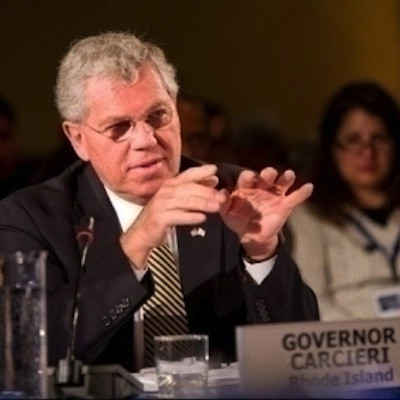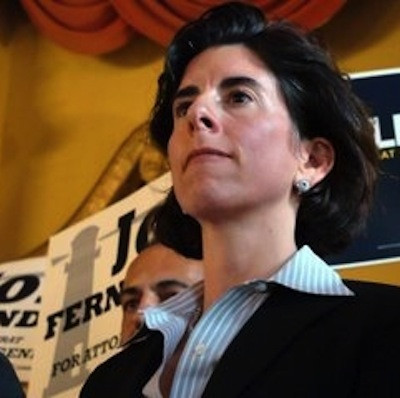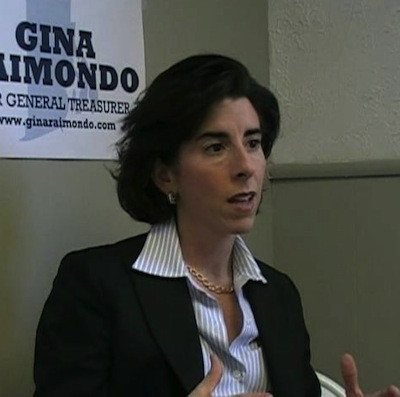Riley: Wild Week Exposes Risks in Rhode Island and Providence Portfolios
Tuesday, August 25, 2015
A wild day on Wall Street followed a very volatile week last week. It was enough to make my head spin and I’m no rookie. I have literally managed hundreds of millions of dollars during the most difficult markets in history. I was there in the crash of 1987 when the market lost 22% in a single day. I was there in 1998 for the long term capital disaster and the Asian currency and Ruble crisis. I was deeply entrenched as a partner of the world’s largest Options Specialists firm in 2000 at the height of the Dot.Com bubble. And unfortunately I was there on September 11, 2001.
Frankly I’m glad to be alive after all these events including my 3 heart attacks. I’m now on my third pacemaker. I’ve been literally carried off the Amex Trading floor a few times and sent to NYU Downtown Hospital. The Trade Center was the last straw though and I sold my business in 2002 and in 2003 I moved to Rhode Island to sit out a non-compete clause with TD Bank. In 2006 my ex floor partners and I started our first hedge fund. We called it Narragansett Multi-Strategy Fund. It has been funded by friends and family and I still manage it today, along with my partner Danny Mintz. My partner and I manage money and manage risk and have done so since 1975. We trade quite actively and are very sensitive to derivatives pricing in selecting our strategies.
I bring this up because we’ve been analyzing and managing portfolios for 40 years and we know instantly by looking at a portfolio how risky it is and whether the risk reward is appropriate. We differentiate between trading and investing. When managing client assets and retirement portfolios, which we also do for Beach Street Financial Services LLC and others, we used low risk “Defined Outcome” strategies. These simple, transparent and liquid strategies are exactly what Providence Pension Fund and the State of Rhode Island pension funds should be invested in.
GET THE LATEST BREAKING NEWS HERE -- SIGN UP FOR GOLOCAL FREE DAILY EBLASTTrading versus Fiduciary
Unfortunately both the State and the City pension funds are deeply underfunded. As fiduciaries, they are required to act in a fiduciary manner safe-guarding the assets in the Pension Trust. The client or beneficiary well-being comes first.
Providence's pension plan is funded at only 25% and the State is near 55% funded. It’s obvious that neither fund can afford big losses. That was a consistent line in Ms. Raimondo’s pension reform of 2011 -- clearly, as fiduciaries plan managers would therefore have very little “risk” in their portfolios. Well, that’s clear to me and most fiduciaries but apparently not clear to Mayor Elorza. Both the current Providence Pension fund construction and the performance of Providence investments are abysmal.
The City has outright lied about Plan assets to the tune of $63 Million in the current year. How can they get away with that? So here is the scoop, as of June 30 2014 the investment commission (responsible for investing the contributions every few weeks from the city and its employees) had only $260 million in investments, however the city council and mayor reported assets of $380 million that included an illegal IOU of $57 million on June 30 2014 “owed” to the pension fund from the city. Against a back drop of $1.25 billion in accrued liabilities, the city is in desperate straits.
The hired manager, Wainwright Investment Counsel, is placed in the impossible position of having to make 8.25% annually, not only on actual assets, but also on the phantom assets. This tension has existed since Buddy Cianci hired Wainwright in 1995. Outside observers might think the worst thing that could happen to Providence Pension Plan assets would be a lousy stock market and therefor as fiduciaries the Investment commission headed by Elorza should guard against losses. Safety right? Wrong!!
The commission chaired by Mayor Elorza has done nearly the opposite. The Providence Pension fund is significantly riskier than most pension plans as well as the State pension fund. Elorza's largest current investment is in an aggressive long short hedge fund, Renaissance. It is important to understand that the standard allocation of assets for fiduciaries managing pension funds is a 60/40 allocation of stocks vs other categories. That 40 % allocation is usually dominated by fixed income. Short duration is less risky than long duration and domestic vs international is usually less risky. Strikingly, the worst funded pension plan in America aka “the Providence plan” is over 70% invested in stocks and tilted toward small and international, both very risky. The Fixed income portion is about 24% with 5% in international debt. This is not a conservative portfolio in anyone’s judgement much less a portfolio that is managed for an employee pension fund.
How has Providence high risk portfolio performed?
The rate of return for the Providence Pension Fund for fiscal year 2015 was a miserable 3.3%. That result is fully 500 basis points below the required compounded MINIMUM return of 8.25% that Providence projects for the next 30 years. A whopping miss, but even worse when you take into account lying and cheating.
Wainwright did in fact make 3.3% on the money/assets they actually managed of $265 million dollars. Wainwright's return of 3.3% on $265 million is about $9 million dollars. However the Mayor reported, in official documents, assets of $380 million dollars and thus the expected return on $380 million was $31.3 million. This $22 million dollar shortfall doesn’t just disappear. It compounds. The Providence strategy of high risk with low returns is no way to run a pension fund. Mayor Elorza should be embarrassed.
What about Seth Magaziner?
Seth manages the $8 billion dollar pension portfolio for public employees in the State of Rhode Island. Seth campaigned on his “record as a money manager” and emphasized the reason for electing him was his experience and his expertise.
In his 2014 campaign in the written press, on national tv and on the debate stage he repeatedly referred to his "30% plus returns”, promising to bring that skill to the state. Well, that was all a lie.
Seth never managed money or had any track record whatsoever. But that didn’t stop the Projo editorial board from endorsing him over Ernest Almonte. Seth is now almost 8 months into the job and thanks to his transparency efforts we can clearly see that Seth is failing. So the insiders newspaper Projo strikes again and their pick Seth Magaziner has performed badly. Rather than the promised 30% genius or even the State minimum return of 7.5%, the State pension plan is now in the red and instead of a portfolio built for safer returns, we have no returns at all and very little safety. The plan is just as complicated and expensive as when Gina had it, only now thanks to “transparency” we can see it a little more clearly.
Seth knows exactly how the State is doing right now, but he chooses not to comment so we will wait a few weeks until he lets us all know the bad news. The treasurer would surely be crowing if the market were up 10%. However, we calculate that the State is down for both the calendar year 2015 and also for the fiscal year 2016. In fiscal 2015 in which Mr. Magaziner managed for 6 months the State had a whopping $500 million dollar shortfall. There is great concern that now, with the markets in free fall retirees are relying on someone who has never managed money to make the right calls. This worrisome fact, combined with Seth’s refusal to acknowledge or address Providence’ misleading bondholders and its near bankruptcy, has us wondering what does Seth actually do each day other than run for his next office?
My suggestions: Trader vs Fiduciary
These are difficult markets, no doubt. Here’s what I think. As a trader I‘m tempted to wait a few days and make a long side bet on commodities and equities by selling richly priced puts on solid companies levered to the price of oil. As a fiduciary for my clients there is absolutely no change, we will continue using Exceed Investments defined outcome products and strategies. For example: One strategy allows investors individuals or institutions like public pension funds to invest in the S&P 500 through SPY and at the same time be buffered on losses up to 10%. They will also receive approximately 1.4 times the upside return capped at around 11%. This defined outcome investment would be structured for a little over 1 year. Imagine if SPY goes down 7% she loses nothing, if the SPY goes down 15% she only loses 5%. If the spy goes up 3% over the next year she will make 4.2%. All the investor gives up is the cap on return. My suggestion is that the pension fund rid themselves of 55 managers, the 120 different investments and all the million dollar consultants and simply use Exceed Investments products and strategies.
Disclaimer:
As Viktor Kiam once said “I liked them so much, I bought the Company”.
Coastal Management Group LLC has a significant stake in Exceed Investments and Beach Street Financial Services LLC.
Michael G. Riley is vice chair at Rhode Island Center for Freedom and Prosperity, and is managing member and founder of Coastal Management Group, LLC. Riley has 35 years of experience in the financial industry, having managed divisions of PaineWebber, LETCO, and TD Securities (TD Bank). He has been quoted in Barron’s, Wall Street Transcript, NY Post, and various other print media and also appeared on NBC News, Yahoo TV, and CNBC.
Related Slideshow: Timeline - Rhode Island Pension Reform
GoLocalProv breaks down the sequence of events that have played out during Rhode Island's State Employee Pension Fund reform.
Related Articles
- Riley: How to Start Fixing the Rhode Island State Pension Fund
- Riley: Repeating My Call for Providence Bankruptcy
- Riley: Providence Pension Scam is Unraveling
- Riley: Providence Pension Scam Revealed in Print
- Riley: Leaders Silent on “Enron-esque” Providence Pension Debacle
- Riley: Pension Settlement Does Little to Help Rhode Island
- Riley: Progressive Magaziner and the Discount Rate
- Riley: Providence Pension Fund is Risky Business
- Riley: RI Has $600 Million Shortfall for Fiscal Year 2015
- Riley: Does the RI Treasurer Know his Senior Policy Adviser?
- Riley: Negative Return on Fiscal Year 2015
- Riley: I’ll Gladly Pay You Tuesday for a Hamburger Today
- Fire Fighters Sue Providence After GoLocal’s Riley Unveils Missing $60 Million
- Riley: California Municipal Bondholder Law Follows Rhode Island
- Riley: Providence Rhode Island Defaulted June 30, 2015…So What
- Riley: Simple Questions in Need of an Answer by Providence Officials
- Riley: Providence, Ken Lay and the Securities Exchange Commission
- Riley: Providence’s Cash Flow Problem
- Riley: Comparing Providence to Greece
- Providence Pension Watchdog Riley Releases Report, Calls for More Answers
- Riley: Raimondo and Mattiello Fiddle While Providence Implodes
- Riley: Countdown to Default in Providence
- Riley: Default in Providence. Where is our Governor?
- Riley: A Corrupt Providence Approaches Default
- Riley: Why is Governor Raimondo Misleading Bond Investors?








































